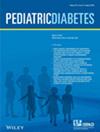Assessing Risk Classification in Medication-Induced Diabetes during Induction Therapy in Pediatric Acute Lymphoblastic Leukemia
IF 3.9
3区 医学
Q2 ENDOCRINOLOGY & METABOLISM
引用次数: 0
Abstract
Medication-induced diabetes (MID) is common during induction therapy for pediatric acute lymphoblastic leukemia (ALL) and has potentially significant negative consequences. Reported risk factors for MID are variable with limited data comparing patients treated with standard-risk (SR) vs. high-risk (HR) regimens. This study aims to evaluate the incidence and risk factors for MID during induction in patients with ALL from the Maritimes over a 20-year period. We performed a retrospective single-center study of 262 patients (142 males, 120 females) diagnosed with ALL at IWK Health in Halifax, Nova Scotia, Canada, from 2000 to 2019. Older age, higher body mass index, greater central nervous system status, Trisomy 21, and prednisone steroid type were risk factors associated with MID in our cohort. HR patients developed significantly more complications than SR patients including MID and infection. Screening for MID should be routine during ALL induction treatment, particularly in those with HR disease.评估小儿急性淋巴细胞白血病诱导治疗期间药物诱发糖尿病的风险分级
药物诱发糖尿病(MID)是小儿急性淋巴细胞白血病(ALL)诱导治疗期间的常见病,可能会带来严重的负面影响。据报道,MID的风险因素不尽相同,对采用标准风险(SR)与高风险(HR)方案治疗的患者进行比较的数据也很有限。本研究旨在评估 20 年来滨海省 ALL 患者诱导期间 MID 的发生率和风险因素。我们对2000年至2019年期间在加拿大新斯科舍省哈利法克斯市IWK健康中心诊断为ALL的262名患者(142名男性,120名女性)进行了回顾性单中心研究。在我们的队列中,年龄较大、体重指数较高、中枢神经系统状况较差、21三体综合征和泼尼松类固醇类型是与MID相关的风险因素。HR患者的并发症(包括MID和感染)明显多于SR患者。在 ALL 诱导治疗期间应常规筛查 MID,尤其是 HR 患者。
本文章由计算机程序翻译,如有差异,请以英文原文为准。
求助全文
约1分钟内获得全文
求助全文
来源期刊

Pediatric Diabetes
医学-内分泌学与代谢
CiteScore
6.60
自引率
14.70%
发文量
141
审稿时长
4-8 weeks
期刊介绍:
Pediatric Diabetes is a bi-monthly journal devoted to disseminating new knowledge relating to the epidemiology, etiology, pathogenesis, management, complications and prevention of diabetes in childhood and adolescence. The aim of the journal is to become the leading vehicle for international dissemination of research and practice relating to diabetes in youth. Papers are considered for publication based on the rigor of scientific approach, novelty, and importance for understanding mechanisms involved in the epidemiology and etiology of this disease, especially its molecular, biochemical and physiological aspects. Work relating to the clinical presentation, course, management and outcome of diabetes, including its physical and emotional sequelae, is considered. In vitro studies using animal or human tissues, whole animal and clinical studies in humans are also considered. The journal reviews full-length papers, preliminary communications with important new information, clinical reports, and reviews of major topics. Invited editorials, commentaries, and perspectives are a regular feature. The editors, based in the USA, Europe, and Australasia, maintain regular communications to assure rapid turnaround time of submitted manuscripts.
 求助内容:
求助内容: 应助结果提醒方式:
应助结果提醒方式:


